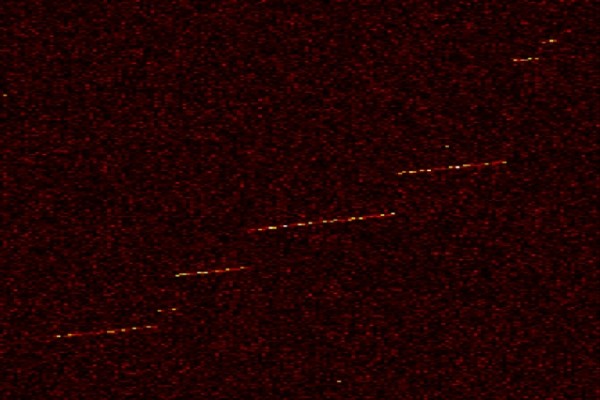New Tabletop Particle Detector Can See Single Electrons
| Marco Foronda | | Apr 23, 2015 03:33 AM EDT |
(Photo : Formaggio and team/MIT) Shown here is "event zero," the first detection of a trapped electron in the MIT physicists' instrument. The color indicates the electron's detected power as a function of frequency and time.
Massachusetts Institute of Technology (MIT) physicists have developed a new tabletop particle detector able to identify single electrons in a radioactive gas.
When gas decays, it produces electrons that can be trapped by a magnetic bottle, and a radio antenna can pick off signals given off by these captive electrons. This technique can allow researchers to map the electrons' precise activity over several milliseconds.
Like Us on Facebook
As the electrons "ping-pong" against atoms in the detector, their energy progresses in a step-like pattern. Researchers can record the activity of 100,000 individual electrons in krypton gas.
"We can literally image the frequency of the electron, and we see this electron suddenly pop into our radio antenna. Over time, the frequency changes, and actually chirps up. So these electrons are chirping in radio waves," said Joe Formaggio, an associate professor of physics at MIT.
Formaggio explains that when a radioactive atom such as tritium decays, it turns into an isotope of helium and, in the process, also releases an electron and a neutrino. The energy of all particles released adds up to the original energy of the parent neutron.
Measuring the energy of the electron, therefore, can illuminate the energy-and consequently, the mass-of the neutrino.
The process could aid scientists achieve an even greater feat: measuring the mass of the elusive neutrino.
Billions of these "ghostly" particles pass through the body every second, but are yet to be conclusively detected. Scientists have set theoretical limits on a neutrino's mass, but are still finding difficulty gaining more insight into these particles.
Researchers hope to measure electrons in the radioactive atom tritium using a massive spectrometer as part of an experiment named KATRIN (Karlsruhe Tritium Neutrino Experiment). It can detect electrons using a silicon detector, which means the electrons smash into the crystal, and a lot of random things happen, essentially destroying the electrons.
Based on the precision of measuring krypton gas, the same could be achieved with tritium within the next two years, potentially resulting in an accurate measurement of the mass of a neutrino.
The findings appeared in the journal Physical Review Letters.
TagsNew Tabletop Particle Detector Can See Single Electron, electron, Tabletop Particle Detector, radioactive gas, "ghostly" particles, krypton gas
©2015 Chinatopix All rights reserved. Do not reproduce without permission
EDITOR'S PICKS
-

Did the Trump administration just announce plans for a trade war with ‘hostile’ China and Russia?
-

US Senate passes Taiwan travel bill slammed by China
-

As Yan Sihong’s family grieves, here are other Chinese students who went missing abroad. Some have never been found
-

Beijing blasts Western critics who ‘smear China’ with the term sharp power
-

China Envoy Seeks to Defuse Tensions With U.S. as a Trade War Brews
-

Singapore's Deputy PM Provides Bitcoin Vote of Confidence Amid China's Blanket Bans
-

China warns investors over risks in overseas virtual currency trading
-

Chinese government most trustworthy: survey
-

Kashima Antlers On Course For Back-To-Back Titles
MOST POPULAR
LATEST NEWS
Zhou Yongkang: China's Former Security Chief Sentenced to Life in Prison

China's former Chief of the Ministry of Public Security, Zhou Yongkang, has been given a life sentence after he was found guilty of abusing his office, bribery and deliberately ... Full Article
TRENDING STORY

China Pork Prices Expected to Stabilize As The Supplies Recover

Elephone P9000 Smartphone is now on Sale on Amazon India

There's a Big Chance Cliffhangers Won't Still Be Resolved When Grey's Anatomy Season 13 Returns

Supreme Court Ruled on Samsung vs Apple Dispute for Patent Infringement

Microsoft Surface Pro 5 Rumors and Release Date: What is the Latest?










